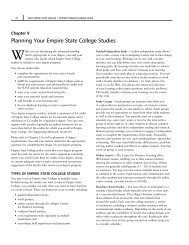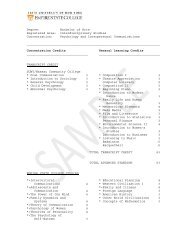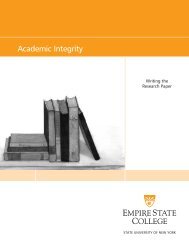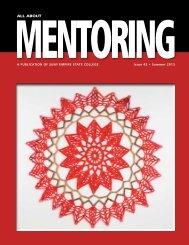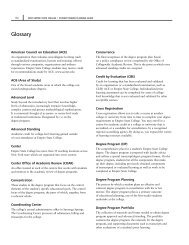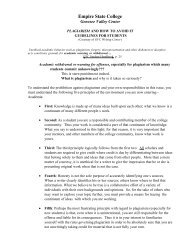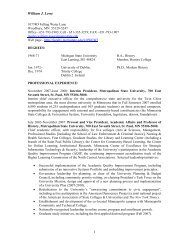All About Mentoring Spring 2011 - SUNY Empire State College
All About Mentoring Spring 2011 - SUNY Empire State College
All About Mentoring Spring 2011 - SUNY Empire State College
Create successful ePaper yourself
Turn your PDF publications into a flip-book with our unique Google optimized e-Paper software.
3<br />
Imagination and Art: Children Cope with War<br />
Judith Gerardi, Metropolitan Center and Center for International Programs<br />
Childhood and warfare symbolize<br />
opposing ends of life experience.<br />
We cringe when the two occur<br />
together, as they increasingly do. Bewildered<br />
children make efforts to lead a child’s life as<br />
they are faced with militia attacks, bombs,<br />
deportations, and continuing loss and<br />
change. Powerless adults make efforts to<br />
protect children and to see them as having<br />
a normal future, actively pursuing those<br />
goals in the midst of war, deprivation, and<br />
continued threat and likely death. While<br />
children often weather armed conflict<br />
remarkably well, it is not without worry,<br />
terror, frightening thoughts, and uncertainty<br />
about their future. Who are these children<br />
and how can we understand their experience<br />
and psychological reality How do they<br />
psychologically cope with living in a war<br />
zone Both surviving victims and those who<br />
perished report to us through their diaries,<br />
essays and drawings. This paper addresses<br />
their drawings, a means for self expression<br />
and, often, coping with extreme danger.<br />
In their drawings, children express<br />
themselves nonverbally in ways that often<br />
are more natural for them than are words.<br />
They enter their inner world as they draw<br />
and can usually achieve a level of truth<br />
that reflects their reality. Further, since the<br />
communication does not rely on a particular<br />
language, the child’s voice can speak to<br />
any viewer. While individual and cultural<br />
meanings cannot be interpreted from the<br />
drawing alone, the child’s primary reality<br />
as presented in the drawing is usually clear.<br />
Freed from the limitations of language, we<br />
can read children’s drawings to learn about<br />
a shared experience of events that may be<br />
separated by time and location. War is such<br />
an event.<br />
An important aspect of healthy<br />
psychological development is free<br />
exploration of the actual environment<br />
and the one beyond it, the imagined or<br />
hypothetical environment of fantasy.<br />
Both exploration of day-to-day life and<br />
of the imagined world of fantasy are<br />
compromised during extreme threat,<br />
including war. Danger restricts physical<br />
exploration of the actual environment. It<br />
also can restrict mental exploration of the<br />
imagined environment. Imagination often<br />
fails to contribute to healthy psychological<br />
coping when the individual’s psychological<br />
energy is focused on survival and cannot<br />
offer an emotional release or a means of<br />
creating mental solutions to the chaos of<br />
bombardment, deprivation and loss. Instead,<br />
fantasy becomes restricted, dominated by<br />
efforts to psychologically tolerate extreme<br />
physical and emotional upheaval. In<br />
effect, imagination gets stuck, unable to<br />
satisfactorily aid ego development.<br />
Yet imagination also has the potential to<br />
retain its role in healthy mental exploration,<br />
the focus of this paper. The use of<br />
imagination operates in two interrelated<br />
ways in relation to compensating for<br />
the restricted physical exploration of the<br />
child’s environment that is associated<br />
with life in a war zone. First, it allows self<br />
expression. The child can create a world<br />
that he controls, one in which he can find<br />
emotional release, take on new and different<br />
roles, and express his innermost reactions<br />
and thoughts. Second, for some children,<br />
imagination allows mental exploration that<br />
begins to address psychological coping.<br />
Self Expression<br />
The first way in which imagination provides<br />
an antidote to restrictions of place brings<br />
the child beyond the miserable, limiting,<br />
dangerous world of war so that he can<br />
create the world that he needs. In that<br />
world, he can freely engage in mental<br />
exploration of his observations and<br />
thoughts. The child finds that he can create<br />
and occupy a visual representation of his<br />
psychological reality. Against a background<br />
of group suffering and powerlessness,<br />
imagination provides affirmation in the form<br />
of recognition of the child artist’s individual<br />
being. This first way in which imagination<br />
operates during war, then, is centered on self<br />
expression. It facilitates emotional release<br />
and the preservation of the child’s sense of<br />
individuality.<br />
Mental Exploration<br />
The second way in which imagination<br />
provides an antidote to restrictions of<br />
place, psychological coping through mental<br />
exploration, allows the child to entertain<br />
solutions in fantasy that are not possible<br />
to her in the real world. This possibility is<br />
severely restricted by the physical danger<br />
and emotional tension of war, which<br />
threaten the typical ways that children’s<br />
imaginations serve their psychological<br />
well-being and mental life. However, when<br />
imagination continues to operate more<br />
freely, it can provide an alternative to the<br />
reality of war. The child can continue to<br />
explore possibilities in her imagination<br />
that are unavailable in the danger of a war<br />
zone. I will give examples of drawings that<br />
illustrate these points.<br />
Children’s Psychological Experience<br />
of War: The Drawings<br />
The drawings presented and discussed in this<br />
paper were created by children aged 6 to 14<br />
during four different wars spanning close<br />
to 70 years, from the Spanish Civil War<br />
(1936-1939) to Darfur (2003-2010), thus<br />
representing different time periods, regions<br />
and world cultures. They show disturbing<br />
similarities, including portrayals of<br />
explosions, destroyed structures, mutilated<br />
and dead people, family, dislocation, and<br />
monsters. They show the mayhem of<br />
attempting to escape the assaults. This is<br />
what children see, and it continues. I believe<br />
that you will be struck by the common<br />
experience visually reported by these<br />
children. The drawings selected for this<br />
paper were placed in five groups: transition<br />
suny empire state college • all about mentoring • issue 39 • spring <strong>2011</strong>




